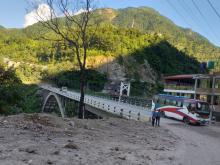The Muglin to Narayanghat road provides an important connection as it links the Prithvi Highway with the East-West Highway. Nepal’s Roads Department intends to optimise the building process by using prefabricated steel and concrete bridge deck components that will be placed on top of pillars erected onsite. The World Bank will provide funding to construct 14 of the bridges required. The Muglin to Narayanghat road passes through widely varying terrain, with much of the route following the path of the Trishuli River. At its southern end the road runs through a flood plain area that is comparatively well-populated and is used extensively for agriculture. The northern end of the road however is in a mountainous area and poses rather different challenges to construction.
Nepal bridge building receiving funding
Financing from the World Bank will help pay for bridge building work in Nepal. The road from Muglin to Narayanghat is being widened currently, which will see the route featuring a lane in either direction, rather than the single lane that carries all traffic at present. This will boost its capacity and reduce delays to drivers on the route, which carries around 20,000 vehicles/day. Improving the 36km, north-south route however requires the construction of 18 new bridges. Much of the route is already surface
Financing from the 2332 World Bank will help pay for bridge building work in Nepal. The road from Muglin to Narayanghat is being widened currently, which will see the route featuring a lane in either direction, rather than the single lane that carries all traffic at present. This will boost its capacity and reduce delays to drivers on the route, which carries around 20,000 vehicles/day. Improving the 36km, north-south route however requires the construction of 18 new bridges. Much of the route is already surfaced with asphalt but the upgrade is seeing remaining sections being surfaced.









